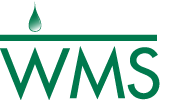Hydrologic Modeling with GSSHA & WMS
Course Description
The 2D hydrologic modeling course begins with an overview of the hydrologic modeling capabilities available in the Watershed Modeling System (WMS). In the course, you will learn about the US Army Corps of Engineers Gridded Surface Subsurface Hydrologic Analysis (GSSHATM) model. GSSHA is a 2D hydrologic model that can be used to model basic watershed rainfall/runoff processes. GSSHA can also be used to model more advanced watershed processes. This course will introduce how to set up basic and advanced GSSHA models using WMS. You will also learn about a lot of the cutting edge post-processing tools available in WMS.
Course Outline - 4 Days
- Learn about images and coordinate systems in 2D hydrologic modeling
- Use geographic information system (GIS) vector data, elevation data, and other spatial data to create and parameterize the 2D hydrologic models
- Easily obtain spatial data using web services
- Delineate watersheds and gridded models using data obtained from web services
- Modify basic GSSHA models to include more advanced watershed process such as land use change scenario modeling, wetland hydraulics, sediment erosion/deposition, spatially varying precipitation (RADAR rainfall), long-term simulations, regional-local model linkages, overland flooding scenario modeling and groundwater flow simulations
- Learn about resources available to help you learn more about GSSHA and WMS
Course Agenda
| Day 1 |
|
| Day 2 |
|
| Day 3 |
|
| Day 4 |
|
Instructors
Course instructors will be chosen from the following qualified personnel as available:
Dr. Christopher M. Smemoe - Lead WMS developer, Aquaveo, LLC. Primary developer of the WMS software, Chris is experienced in many lumped parameter and 2D hydrologic models. He also has specialized expertise in hydraulic modeling and floodplain mapping methods. Chris is the author of several published papers and has taught various professional courses on hydrologic and hydraulic modeling.
Dr. Tony Melcher - Engineering Consultant, Aquaveo. Tony has extensive experience in hydrology and hydraulic related applications including lumped parameter and 2D hydrologic models, as well as 1D and 2D hydraulic models. Dr. Melcher led the Technical Support group at Aquaveo for two years.
Tom Moreland - Engineering consultant at Aquaveo and past developer of SMS; Tom has over 10 years of experience working with SMS and teaching SMS courses at locations throughout the world.
Cost
The cost of the 3-day course is $1495 (USD) per attendee. Save on all registrations made at least 30 days prior to the course. Add $100 to the price above for late registration.
Registration includes the following:
- Instruction and hands-on use of the Watershed Modeling System (WMS)
- Comprehensive Course Notes
- Software CD containing the WMS software, tutorials, and documentation
- A 30-day trial license of the full Watershed Modeling System
- 25% Discount (up to $500.00) on the purchase of an WMS license (not including subscriptions)
Training Attendee Cancellation Policy
Course Requirements
Participants may be required to provide their own computer with the following specifications:
- Windows XP, Vista, 7 or 8 operating system
- 1 GB RAM (2 GB recommended)
- CPU: GMS software is CPU intensive. Some models and utilities such as Parallel PEST can take advantage of multiple processor cores simultaneously.
- Graphics Card: For all display features to be enabled, OpenGL 1.5 or higher must be supported. The use of a dedicated graphics card is strongly recommended. Integrated graphics can result in significantly reduced performance and may not support some visualization features.
- 1024x768 resolution (1280x1024 or higher recommended)
Location/Accommodations
To be announced
Transportation
Attendees should fly into the Salt Lake International Airport (SLC), then drive, take a taxi or schedule a shuttle.
- - - - - - - - - -







